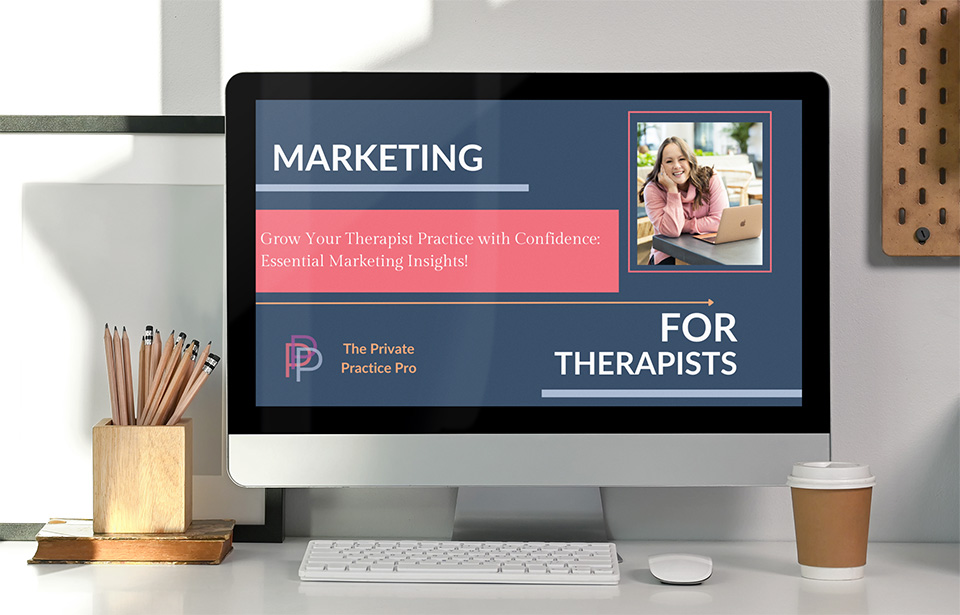10 Proven Strategies to Market Your Therapy Practice Effectively
Many therapists enter their profession with a strong desire to help others but find themselves unprepared for the business side of running a practice. Marketing can feel daunting, but it’s essential for maintaining a steady flow of clients. It’s about much more than just filling your calendar—it’s about reaching those who need your services and making your practice sustainable.
I’m here to help you develop strategies and tools to market your practice. This includes marketing strategies for therapy private practice. Like me, you may have entered the therapy profession to make a difference in your clients’ lives. When I began my practice, I quickly realized that having clinical skills and actually getting clients to make appointments were two very different things. This guide is ideal if you’re starting a private practice or actively building a private practice. This Marketing for Therapists Guide is born from my journey and will help you bridge the gap between what you learned in graduate school and building a successful practice.
This guide is full of tips and strategies for marketing effectively. These were developed through my personal experience over the last decade, building two six-figure private practices, serving as the marketing director of an extensive group practice, and coaching over 2,500 therapists through my Marketing for Therapists course. I promise, by the end of this article, you’ll have tools needed to attract clients in an authentic, compassionate way. Whether you’re researching how to start a private therapy practice or searching for online marketing for therapists, you’ll find actionable steps here. (If you like what you see and want to take an even deeper dive, I invite you to check out my Marketing for Therapists course here.)
Marketing vs. Branding vs. Advertising
It’s easy to confuse marketing, branding, and advertising, but they are distinct:
- Marketing involves all activities to attract new clients, from networking to online ads. Marketing for therapist practices involves combining various marketing tools to increase visibility and client engagement.
- Branding is a subset of marketing focused on building awareness of your practice and identity as a therapist, ranging from business cards to publishing books.
- Advertising is one of many marketing channels, typically involving paid promotions about your practice.
Each of these elements plays a role in a comprehensive marketing strategy. You can market your practice and build your brand organically through referrals, newsletters, or social media without paying for advertising.
The Importance of Marketing in Therapy
Why should you market yourself? Many people hold misconceptions about marketing, saying things like:
- I am afraid that other therapists will judge me for promoting myself.
- Marketing is too expensive.
- I became a therapist to do therapy, not to build a business.
- Only large practices with big budgets are successful at marketing.
These misconceptions stem from a misunderstanding of marketing’s role. In reality, marketing is about visibility, accessibility, and access to services. If your ideal therapy clients can’t find you, they won’t get the help they need! Effective marketing ensures people who need your services can find you, which in turn reduces barriers to mental health care. In today’s healthcare landscape, mental health professionals must use marketing strategies to remain competitive and accessible.
How to Start – Choosing Your Niche and Ideal Client
Because you want to attract and serve the clients best suited to your skills and practice, the first step in marketing is identifying those ideal clients and your niche. Tailoring your marketing efforts to a specific niche helps ensure you’re attracting clients who will benefit most from your services and align with your professional strengths. Your niche also determines your keyword strategy for search engine optimization and other marketing campaigns. To choose your target audience and make your marketing more efficient and effective consider:
- Your Training: Do you have specialized training that allows you to help specific client subsets, like families or teens?
- Your Modalities: Who benefits most from the modalities you use?
- Your Location: If you see clients in person, what types of clients live nearby? If online, would clients in your time zone be more beneficial?
- Your Lived Experience: What personal mental health journey or shared experiences uniquely qualify you to help certain clients?
- Your Skills and Background: Fluency in another language, experience with specific disabilities, or a background in an underserved community can influence your marketing decisions.
Reflect on your best client—the one who benefited most from your care and helped you grow as a therapist. Use them as a model for your ideal client, and remember, you can always change your target audience as your practice evolves.
Creating this profile to develop your niche will increase effectiveness and make it more likely to reach the appropriate pool of clients. Segmentation helps you personalize marketing communications to resonate deeply with specific groups.
Need help finding and defining your niche? Check out my ebook here

Developing Your Voice, Tone, and Values
The voice and tone in your marketing communications differ from your clinical voice. One important thing I remind students in my Marketing for Therapists Course is that your marketing should reflect your values, personality, and clinical orientations. Using LinkedIn, blogs, or social media platforms, maintaining a consistent voice is essential for brand recognition.
When creating your marketing materials, your website, and/or your online profile, use a consistent voice across all platforms and adjust your tone based on the context. Your voice is unique to you, composed of vocabulary, sentence structure, and punctuation, and remains fairly consistent. Your tone, however, is more fluid and changes depending on the context and audience. When marketing yourself, use a natural voice that reflects who you are:
- First Person: Refer to yourself as “I” to avoid sounding overly formal or distant.
- Second Person: Address potential clients as “you” to create a more personal connection.
Focus on the client’s needs rather than just listing your credentials. Use straightforward, accessible language and avoid academic jargon.
Visuals- Use Professional Headshots
High-quality headshots are a critical component of your marketing materials. A headshot is your first introduction to your clients. You want to appear professional, open, and inviting- someone clients can rely on to help them negotiate their struggles. Comfort and connection will be embedded in a good professional headshot. If budget is a concern, you can create a well-lit, high-resolution photo with a smartphone. Be sure the profile reflects the professionalism described above.
How to Connect- Building a Website
Your website is your digital storefront and crucial marketing asset. It should include essential information such as:
- Your name, credentials, and location
- Your headshot
- Information about your services
- Session rates
- Availability (in-person, remote, or both)
- Insurance details
- A contact form
In addition, including an informal introduction instead of just a list of credentials will go a long way in helping your potential clients connect with you, making them more likely to reach out.
You can decide whether to create a website yourself using platforms like Wix or Squarespace, which offer templates and tools for a modest monthly fee, or hire a web designer for a more customized look. I highly recommend Thepassivepractice.com, they built my website and always do an amazing job.
The choice is yours and depends on your budget and aesthetic. DIY options are generally cost-effective and quick, while professional designers can provide a polished and unique site. Your website should be optimized with SEO, relevant keywords, and a blog to support search engine visibility.
If you need some help download my free guide to building a private practice website.
Search Engine Optimization (SEO)- What is it and how do you incorporate it?
Search Engine Optimization (SEO) helps your website rank higher in search engine results. This happens when you include the words most frequently searched which relate to your practice and services, making it easier for potential clients to find you. Using relevant keywords, like “family counseling in [Your City],” throughout your site will improve your visibility. SEO is essential for making your website visible in search results. Search engine optimization involves keyword research, blog content, internal linking, and understanding CPC (cost per click) for targeted terms. Consider hiring an SEO consultant for more detailed strategies and help to optimize your site with relevant keywords.
Listing Your Therapy Practice in Directories
You can connect with clients by using online directories. These are powerful tools for reaching new clients. Popular options include Psychology Today, TherapyDen, and inclusive directories like Therapy for Black Girls. Some directories are free, while others require a fee. When creating your profile, use first-person language and address your ideal client directly. You can often use videos as an effective way to introduce yourself. These directories are great low-cost private practice tools for therapists to enhance visibility.
Building a Referral Network
Networking with other professionals is a valuable way to create community and receive referrals. It can help clients find the right therapist and solve problems for other professionals in your network. You can attend local events, workshops, and conferences to meet other therapists and potential referral sources. Building these relationships can help you find clients who need your specific expertise and get your name and reputation into the community.
Joining a National Association
You can expand your network with membership in professional associations like the American Psychological Association or the National Association of Social Workers. Valuable resources are often available through these groups and participating in these communities keeps you informed and connected. Consider joining state-level associations and taking leadership roles to further enhance your professional connections. Membership fees are often tax-deductible.
Using Social Media
Social media can be a powerful tool for building your practice’s brand and reaching potential clients. Share your expertise, engage with followers, and join relevant groups in spaces like Instagram, LinkedIn and/or Facebook. Maintain a manageable posting frequency, engage with other professionals, join relevant groups, and prominently feature your headshot. If you provide consistency and authenticity in your posts it will help you build a loyal audience and reach potential clients.
Leveraging TikTok and Video Platforms
You can create short-form video content on platforms like TikTok and Instagram Reels. These can reach a broad audience where you might share tips, answer common questions, and introduce yourself to potential clients. These platforms have their own trends and best practices, so familiarize yourself with them to create engaging content. Platforms like YouTube also offer long-form content opportunities that improve SEO and build trust.
Starting a Newsletter
Email newsletters are a reliable way to maintain contact with your audience. Sharing valuable content regularly will keep your practice top-of-mind. Tools like MailChimp, Convertkit, and Substack can help you manage your email marketing efforts.
Hosting Community Events
Community events can raise your profile and build your referral network. Consider hosting workshops, networking events, or presentations tailored to your specialties. Promote these events through your website, social media, and local organizations. Think about connecting with local colleges or universities with programs for therapists. You may be able to add value to an event they are hosting. Depending on your target clients you might also reach out to schools as host to events for families and teens.
Experimenting with Paid Ads
Paid advertising on platforms like Google and Facebook can amplify your reach. If you choose this path, start with a small budget and experiment with different keywords and demographics to see what works best for your practice. Understand the cost-per-click model and target less competitive search terms to manage costs. Paid ads should be part of broader marketing campaigns with clear ROI goals and keyword segmentation. Learning about paid advertising now can prepare you for future marketing campaigns.
Tracking and Adjusting Your Marketing Strategy
Marketing is an ongoing process. Regularly review your strategies to see what’s working and make adjustments as needed. One key resource you have is asking new clients how they found you and use this data to refine your approach. Track metrics across platforms like Google Analytics, email marketing tools, and CPC reports to assess what’s performing.
Marketing for Therapists: A Course by Kelley Stevens
For a more comprehensive guide, consider enrolling in Kelley Stevens’ “Marketing for Therapists” course. This course provides in-depth training on building and promoting your therapy practice, including social media strategies, website optimization, and creating effective referral networks. If you’re searching for a therapist guide to modern marketing techniques, this course is an invaluable resource.

Conclusion
Marketing your therapy practice is not just about filling your schedule; it’s about connecting with those who need your help. By investing time and effort into strategic marketing, you can ensure your practice thrives and you can continue to provide valuable mental health services.




